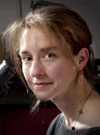Previous Seminars
ICaMB Seminar - Amy MacQueen

- Venue: RB Green Dental Lecture Theatre
- Start: Wed, 18 Jan 2017 13:00:00 GMT
- End: Wed, 18 Jan 2017 14:00:00 GMT
Zippers and Stitches in the Meiotic Nucleus
Abstract
Our research seeks to understand the long mysterious but fundamental cellular mechanisms that drive chromosome dynamics during the differentiation of sex cells. A critical feature of sex cell differentiation is a reduction in chromosome number. During the specialized cell division cycle called meiosis, homologous partner chromosomes somehow identify and specifically associate with one another, and this association ensures their accurate segregation into separate chromosomal complements. A longstanding cell biological mystery is: How does a chromosome search for and ultimately recognize its proper homologous partner in the nucleus? We use genetic, cytological, and biochemical approaches in conjunction with high resolution microscopy to identify the molecules and mechanisms that underlie how meiotic chromosomes interact, how homology detection occurs, and how homology recognition is coordinated with chromosome pairing reinforcement in the budding yeast, Saccharomyces cerevisiae.
A transient yet dramatic reinforcement of initial homologous chromosome pairing occurs via the zipper-like assembly of a tripartite structure, the synaptonemal complex (SC), at the interface of lengthwise-aligned meiotic chromosomes. SC assembly between homologous chromosomes accompanies meiotic double strand break repair events at discrete sites along chromosomes; such homologous recombination events include crossovers (“stitches”), which splice DNA molecules of independent homologous chromosomes and serve to link homologs until their orientation and segregation on the meiosis I spindle. Past studies from our lab revealed several fundamental architectural and dynamic aspects of the budding yeast SC, as well as regulators that ensure SC assembles “at the right place, at the right time”. Our more recent studies have explored the functional relationship between the SC structure, its protein components, and meiotic recombination in budding yeast. Our observations suggest that many of the building block components of the budding yeast SC have distinct functions in meiotic recombination that may have evolved independently of their roles in SC assembly per se. An intriguing set of data indicates that an SC transverse filament protein, Zip1, may be mechanistically involved in crossover recombination in a manner that overlaps the activity of the MutSg complex. Another observation reveals that the SC central element proteins, Ecm11 and Gmc2, promote proper mismatch repair during meiotic recombination. Our research is currently focused on experiments aimed at discovering the molecular features and underlying mechanisms that link such SC structural proteins to their essential roles in meiotic recombination.
If you would like to meet Dr MacQueen during her visit please contact Owen Davies to be added to her schedule: owen.davies@ncl.ac.uk.